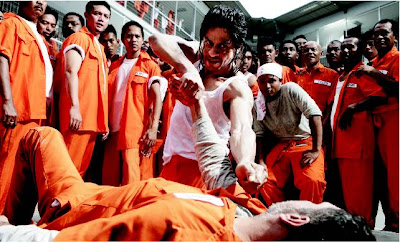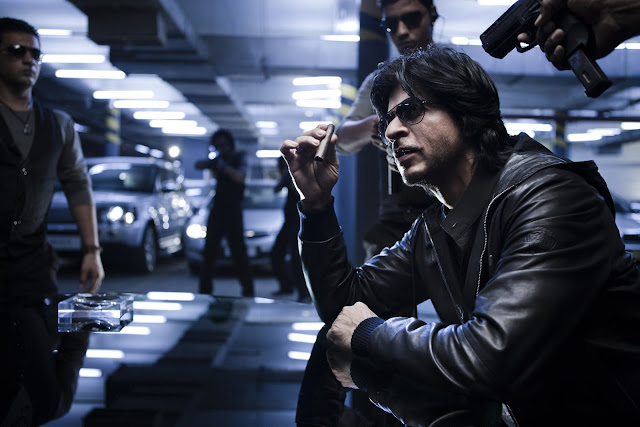Making of Don2
Making of Don2
A tête à tête with cinematographer Jason West reveals his experience shooting one of the most awaited movies of 2011, ‘Don 2.’
Filmed throughout South East Asia and Germany, Don 2 not only boasts a new-age grunge look but also a fresh perspective on filmmaking in India. “The principle idea evolved over sessions we had with Farhan Akhtar (Director). We decided the color scheme once the Production designer, TP Abid, showed us his set design ideas,” highlights Jason. He adds, “These elements gave a rough idea of what the film would look like overall. As we brainstormed, over various sittings, we kept adding elements and synthesizing them. I did not want it to look too glamorous and glitzy but instead raw and real. Something akin to a James Bond movie – slick – but not an 80’s kind of slickness.”
Jason’s relationship with TP Abid turned out to be another feather in the cap. “Abid has good design sensibilities and always came up with fresh ideas. All his designs were pretty much in line with our initial conversations. And sometimes Farhan would move things around for directorial purposes and so he would make those changes,” he comments. Although set design played a tremendous role in guiding the overall feel, each location on this bi-continental production played a role. Jason explains, “We started shooting in October last year and we finished in March this year. The only break we took was for Christmas. We were in Berlin for three and a half months. After Christmas we came back to Mumbai for a month to do the studio shots. Then a couple of days later we were off to Malaysia and Langkawi. The last thing we shot was the song in Mumbai. Every location added its own flavor, sensibilities, and look to the scenes.”
Shot mostly in Germany during winter, the film is dominated by grey tones. With an overcast sky and a rarely visible sun, the film adapted the natural look of the environment. Jason adds, “It was very overcast; we’d rarely see the sun. As time progressed from November to December, days became shorter. It would get dark and cold by 3.30 pm. Typically the locations dictate the look of a particular scene. Rather than fighting against the natural colors, I thought of using them to my advantage.”
From the biter cold to the tropics, the filmmakers were never shortchanged of challenges. Gaffer Mulchand Dedhia describes, “In the opening sequence when the Don blasts the mafia’s adda (den), we were shooting in Langkawi, which had very unpredictable weather. Every 10 seconds the weather seemed to change so we really had to watch out. However, we managed to maintain the lighting continuity extremely well.”
With tight timelines come rigorous planning and a film like Don 2 which includes intricate fight sequences and car chases, keeping things simple, was the mantra. “We filmed the car chases during the day because blocking off streets in Berlin during the night, as per the original schedule, was too complicated.” For the car chases and fight sequences there was a second unit Director of Photography in Germany called Ollie. “We had a lot of conversations during the shoot and shot simultaneously during the car chases. We were totally in sync throughout the execution of the sequences. We had tracking vehicles, crash cameras, and cranes for big stunts. There were about 6-7 cameras 235’s, 435’s, Arri 3’s and 535’s. The placement of the cameras was tricky because we had to be careful that none of them were in each others field of view.”
The shift from exterior and location work to interiors and film sets can be challenging even though a Director of Photography has more control over lighting. Jason reveals, “There is no limitation on the set as we have enough time to pre light. We had to match certain shots in Mumbai for interiors that were shot in Berlin. But on interior locations like an office space on the 10thfloor of a building for example, special considerations need to be accounted for because there are definitely parameters, permission issues etc.”
The production shot in some attention-grabbing locations including a Malaysian prison and an underground location. “The underground location which was in Germany is called a Messe Halle where lots of business events happen. Underneath the large area there is a basement with a labyrinth of tunnels, which is where we shot. Lighting in a tunnel is difficult. You obviously can’t place lights, as they’d be seen on camera. So I just changed the fluorescent tubes in the existing fixtures and tweaked their color temperature using gels. There is a moment in the scene where the electricity gets knocked out. There was no window or light source whatsoever. Realistically one cannot see anything, so to get the shot I used emergency backup lights (shown in the scene) and changed their color to a deep amber at low level.”

Shooting in the Malaysian prison was a challenge. “It was a real prison; very modern and clean. One of the blocks had very few prisoners, so they moved all of them to another block and we were given the entire space. It was very difficult because of elaborate security checks every morning. The problem was that if you stepped out, the whole process had to be redone. Lunch was especially time consuming as the entire crew stepped out. We had to go through this process twice a day. We also shot in the kitchen area of the prison and were there for 6 days. There were some night scenes where I wanted to use a different color scheme. Changing every bulb in every cell in a hundred cells would have been crazy because there were thousands of bulbs to change. That was a limitation.”
Shooting in a prison environment is naturally bleak, void of any color, so the filmmakers wanted to add contrast by selecting the appropriate color for the prisoners’ clothes. Jason recalls, “I thought it should be orange taking the Guantanamo Bay prison in Cuba as a reference. We eventually decided that orange outfits worked very well with the grey. Orange ended up becoming a theme color in the film that audiences may notice. In one of the car chase sequences in Berlin there is a building with only orange tiles for example. As soon as we saw it we decided to use it. Cars going through the orange columns built in the 70’s looked very interesting.”
One of the more elaborate interior sets involved intricately choreographed pyrotechnics. “The set, which is a recreation of a big reception area, where there is a shoot out at the end of the movie utilized emergency lighting as well. Basically all the lighting comes from the set itself. Just for the close ups I used a kino flo or a 650w. We had some lights built in the columns, corners and ceilings. The columns were 4-sided strips. It’s the kind of lighting you get in an airplane and that was the principle idea. We also had to get another light source in there so the fire from the pyrotechnic explosions worked nicely. Additionally some kinos were mounted on the ceiling. I like to use top lights a lot since it provides a lot of shade under the eyes to create a mood.”
Interestingly, some of the more uncomfortable sequences to shoot were a few of the green screen plates. “That was one the hardest things to do. There is a sequence where a conversation takes place in a car travelling through the mountains. We shot the car sequence in a studio in Berlin last year (October) and the plates of mountains in Zurich during March this year. While shooting the plate it was raining and freezing cold. I was sitting on the back of the tracking vehicle with my focus puller. It was one of the hardest and most uncomfortable sequences to shoot,” he says.

Gaffer Mulchand Dedhia describes working with Jason, “He uses a lot of contrast and is crazy about colors which he uses very smartly. Diffusion is rare on Jason’s shoot.” He goes on to describe one of the major lighting challenges; “For the song Zaara Dil Ko Thaam Lo the choreographer wanted the dancer’s silhouettes to grow smaller and bigger behind a screen. That was tricky. We tried a lot of options. We needed a 20ft clearance from the screen to the lighting source in order to achieve the look. In between those movements none of the characters could get cropped. We decided to go with studio profile lighting utilizing very powerful lights, which you can control through cutters and the iris. Studio profile (750 W) is a light that doesn’t utilize too much power, but the reflectors and the lenses are made in such a way that it has a powerful output with really hard shadows. 5k’s and 10k’s didn’t work as the spill was too much around the light.” For the same scene, Farhan wanted the set’s dome shaped ceiling to be lit. The grips and electrics rigged 1600 bulbs on various sections of the dome, wiring them for the desired lighting choreography”.
In a scene with Shah Rukh Khan, Farhan wanted to amplify its dramatic effect through lighting. Gaffer Mulchand continues, “Farhan came up to me and asked if we could create some lighting choreography wherein as he (SRK) walks, fluorescent tubes turn on one by one. With Tungsten it can be done but with fluorescent tubes it gets tricky because as soon as you turn them on they don’t light up immediately. They flicker for a second and then power up. So I used high-speed ballasts and changed the circuits for the tubes.”
The team worked with colorist and visual effects artist Paul Byrne from Pixion. Jason who has had an eight-year working relationship with him said, “The last few films he worked on were ‘Rock On’ and ‘Delhi Belly’ so he knows what I like. In this film we have just enhanced the look. I tried to achieve everything we wanted in camera during the shoot. Even Farhan wanted to keep it that way. We tried a few things during the first [color] grade and Farhan came to see it. He liked the way it was shot so it worked out well. We usually started by just balancing the RGB and then decided whether we wanted to change anything. There were a few elements like tweaking a color in the background, bringing down the levels on signage that was popping, and some sky replacements. Many times things are not in your control. There are so many skin tones in India so DI [Digital Intermediate] really helps to enhance certain skin tones especially when all the characters are placed together. So trying to get that balanced can get difficult. During some of the exterior sequences in Berlin, for example, I wanted to cool things down with a little blue. But with some Indian skin tones it tends to make the skin a little chalky. So the great thing about DI is that you can pull out the natural skin tone from it,” explains Jason adding that during the whole process, lighting the actors was the only real problem he faced.
 Jason’s work dynamic with Farhan was efficient and seamless. “Farhan and I didn’t clash at all. He was very specific about certain things but quite flexible when I had ideas. He was so clear about the scenes that it made my job very easy.”
Jason’s work dynamic with Farhan was efficient and seamless. “Farhan and I didn’t clash at all. He was very specific about certain things but quite flexible when I had ideas. He was so clear about the scenes that it made my job very easy.” Lenses – Cooke S4
Films stock – 250 D and 500 T Kodak Vision 3
Perf – 3perf

